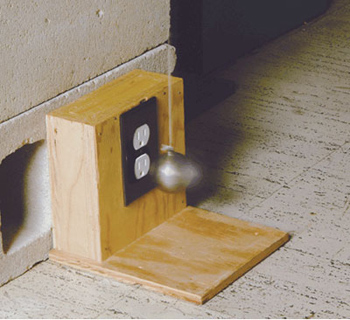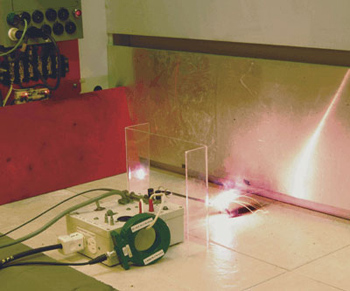These are challenging times for the electrical inspection community, safety organizations such as Underwriters Laboratories, the Consumer Product Safety Commission, and electrical device manufacturers. As proof, just look at the electrical infrastructure inside today’s homes.
New homes are getting bigger and bigger, and a wider variety of electrical products are being installed in these homes than ever before. The list includes big-draw items such as hot tubs, sensitive electronic equipment like plasma TVs, and house lighting under microprocessor control. Even fluorescent lights that use electronic ballasts have altered the residential electrical landscape.
At the same time, electrical inspectors are encountering a new level of complexity inside the modern home, as high and low voltage devices become integrated into a single system. Home automation systems can now link HVAC components, alarm systems, indoor and outdoor lighting, and telecommunications. Today, homeowners on the way home from work can call their house from a cell phone to raise the thermostat and turn on the hot tub.
For electrical device manufacturers, this is the next frontier. And for manufacturers that have their own testing labs, there are challenges ahead that are unlike anything in the past. Leviton’s testing lab, for example, which was established in the 1930s to test the safety of receptacles, switches and light sockets, has recently increased its in-house capabilities to test much more complex devices. In developing new testing procedures, the lab has also deepened its relationships and cooperation with safety organizations and the electrical industry.
This is exemplified by the recent developments with GFCI devices. Field reports were coming into the Leviton lab describing a number of GFCI failures. Some were due to environmental degradation, but most were caused by high-surge events. This prompted the lab to sponsor an American Society of Home Inspectors study to gather more definitive data on the failure rate. The study reviewed data from 13,380 building inspections and found that, on average, 15 percent of GFCIs were inoperative when tested. The study found a much higher incidence of failure in areas where lightning is prevalent. In those regions, as many as 58 percent of GFCIs were found to be inoperative.

Photo 1. Ball impact test: A two-pound ball swinging on a pendulum is used to test devices that must withstand greater abuse, such as a hospital grade receptacle
Based on these and other findings, the UL requirements for GFCI devices were upgraded. For some manufacturers, Leviton included, meeting the new requirements required a substantial investment in new testing equipment.
Gone are the days when a lab could confine its testing to 125 volts and 15 amperes. Today, a lab must be able to test products using much higher voltages and current—up to 600 volts and 1000 amperes at Leviton’s lab. Besides subjecting GFCIs to higher surges, this new testing equipment is used for a range of surge-suppression devices, such as power strips and panel-mounted surge protection—devices that are becoming more commonplace in the modern home.
Testing for real-world conditions
An electrical testing lab has many functions. One primary role is to ensure that all products meet, or exceed, UL safety standards. Another is to ensure that all products have the ruggedness to withstand the rigors of the real world. With some products, the UL safety requirement incorporates these real-world conditions. For other products, UL evaluation and testing do not take into account how a device could be used—or rather abused—in the real world.

Photo 2. Arc-detection test: In teh arc detection test, a carbon path arc is generated to determine if an AFCI device can detect the arc
To meet UL standards, a residential-grade receptacle, for example, must undergo a safety sequence in which a machine inserts and withdraws a plug from a receptacle 250 times in succession, each time drawing an arc. This testing sequence creates enough soot to blacken the plug and cause pitting on the surface of the metal blades.
After the final pull test, the plug is inserted into the receptacle once more, current is passed through it, and the temperature, which must be below a certain UL maximum, is measured. Even though a receptacle is not intended to function as a switch, in the real world it does, and the UL standard requires this level of safety.
On the other hand, a device such as a light switch need only make and break a load safely to meet the UL safety standard. Using a Decora residential-grade switch as an example, to meet UL standards the electrical safety test could be conducted by someone in the lab using a cotton swab to turn the switch off and on. But in the lab, that switch will be tested by a machine that simulates the force of a person whacking it with an elbow or fist, the way a teenager rushing out of the house might turn a light switch off.
A manufacturer must also test products to ensure that the safety of the device is not compromised by the rigors of installation. For many years, electricians used hand tools exclusively when installing a device such as a receptacle. The terminal screws on those devices were designed and tested to withstand a certain amount of torque from a screwdriver before the threads would strip out. The design and testing took into account the amount of force exerted by an installer.
Today, the installer is most likely using a power screwdriver to install a receptacle or light switch. That tool can deliver much more torque, especially if the installer is bearing down on that screw until the drill stalls out. So the terminals on today’s devices must be more robust, and the lab must ensure that devices can withstand this type of abuse. Here again, the lab’s safety testing of the device must go beyond what the UL safety standard requires.
The impact of new technology and new materials
Not that many years ago, the ordinary dimmer switch was available in only one design. It had a single knob that could be turned clockwise or counterclockwise to adjust light levels. Testing for this device was rather straightforward. Now there are dimmers controlled by sliders, or by the touch of a finger, or—even more sophisticated—controlled by a microprocessor.
At the basic level, it is still a switch that must meet UL standards for safely making and breaking a load. But this 21st century dimmer switch can be programmed for a variety of mood scenes, or to respond to dawn and dusk commands, or to power line carrier signals.
The ability to test these newer devices requires machinery and procedures with much greater sophistication. For example, in addition to UL safety testing, these microprocessor devices undergo immunity tests to make sure they are not susceptible to external phenomena like static electricity, surges, or radio frequency interference. Imagine what would happen if a homeowner using a cell phone caused the lights to go on and off by themselves.
Along with advances in electronic circuitry, materials have changed significantly. Years ago, every electrical product and appliance had either a metal or porcelain housing. Today, plastic is the material of choice, and it is being used to house large amounts of electricity and power. Take, for example, the ordinary hair dryer drawing 15 amperes on a 15-ampere circuit. The only thing separating a user from that energy is 1/16² of plastic.
Since plastic has become the preferred material for many electrical products, a testing lab must evaluate plastic materials for their tensile strength, hardness, and flammability rating, to ensure that the material does not burst into flames or melt; or should it catch on fire, that it self extinguishes. All of these tests, and the machinery used in the testing, are recent additions to an electrical safety lab.
New product development
To stay ahead of the curve, an electrical testing lab should be continually evaluating new materials as they become available to see if they have characteristics that are suitable for producing electrical products that can be used safely in the field. That includes accelerated environmental testing to ensure that materials can function safely in the environment in which they will be used over their entire lifetime.
An electrical testing lab has another important function—assisting in the development of new products. At Leviton, for example, design engineers know it is not enough to design a new product solely for form, fit and function. Safety must also be a design consideration, from the earliest stages of product development all the way to the manufacturing floor.
When engineers bring their prototypes to the lab, they can observe their new device being subjected to high voltage or high current, and see what events lead up to a failure, and then make design improvements that will enhance its safety. Likewise, when a ten-pound weight is dropped on a device, the engineer can see first-hand if it is rugged enough for the real world.
In the development of new AFCI devices, for example, Leviton design engineers and the lab are taking into account the realities of the way people use electrical products in their homes. Thus, as the industry prepares to endorse AFCI circuit breakers, the Leviton lab is testing new AFCI receptacle designs that incorporate this protection into the receptacle. Here’s why.
In the New York area, and probably in cities and towns all around America, a consumer can walk into a 99-cent store and buy an extension cord. That cord may, or may not, carry a listing mark. If it does, there is also the possibility that it’s counterfeit, as Leviton has discovered with several offshore products coming into the U.S. with bogus listing or certification marks or labels. No wonder the CPSC has several of these inexpensive extension cords on its product recall list.
The Leviton testing lab has purchased a number of these extension cords and tested them in the lab. With some cords, the amount of copper wire is far less than the UL minimum requirement. With others, the insulation material does not meet UL requirements for heat resistance and flammability. When some cords are bent a couple of times, they crack. Yet a consumer can purchase one of these cords and use it with a high-draw appliance, such as an electric heater or hair dryer.
For that reason, it makes sense to put AFCI protection at the receptacle as well as the breaker. AFCI testing is new territory for a testing lab, requiring new equipment and the development of new testing procedures.
The introduction of modern electrical and electronic technology into the home has drawn electrical device manufacturers closer to the electrical inspection community and safety organizations. But it is the kind of challenge that will keep all of us on our toes and one step ahead of the curve.











Find Us on Socials